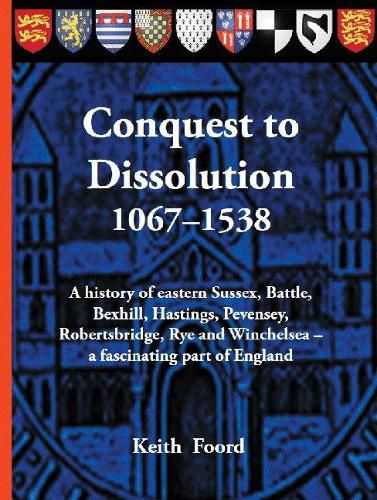Readings Newsletter
Become a Readings Member to make your shopping experience even easier.
Sign in or sign up for free!
You’re not far away from qualifying for FREE standard shipping within Australia
You’ve qualified for FREE standard shipping within Australia
The cart is loading…






This title is printed to order. This book may have been self-published. If so, we cannot guarantee the quality of the content. In the main most books will have gone through the editing process however some may not. We therefore suggest that you be aware of this before ordering this book. If in doubt check either the author or publisher’s details as we are unable to accept any returns unless they are faulty. Please contact us if you have any questions.
In 1066 eastern Sussex was the beachhead for the successful invasion of England by Duke
William II of Normandy. He was crowned William I, King of England, at Christmas 1066
and 1067 was the first year of the Normanisation of England. 1538 saw the dissolution
of the major monasteries and abbeys including those of Battle and Robertsbridge, and the
start of the English Reformation.
How did William and his successors, from the houses of Normandy and Blois, via the
Angevin and Plantagenet kings, through the Wars of the Roses to the rise of the Tudors
change eastern Sussex? Most of the history is hidden away in ancient documents, but some
remains visible, in the ruins of old abbeys and castles and in the landscape itself.
Before 1066 eastern Sussex appears to have been somewhat separate from the sub-
Kingdoms of Sussex - and many would say it still is. It was more influenced by the Kingdom
of Kent to the east than the rather fragmented Sussex to the west. It was at times called
Hastingas - which existed from about the 6th to the early 11th centuries. This evolved
to became the part of Sussex called the Rape of Hastings, which, with the Hundred of
Pevensey, makes up ‘1066 Country’: eastern Sussex. It stretches from Pevensey to Rye, and
inland from the coast to the Kentish boundary. Battle and its abbey sits at its heart, on the
site of the Battle of Hastings.
The ways in which Battle, Bexhill, Pevensey, Robertsbridge, Rye, Winchelsea and all of
eastern Sussex evolved between 1067 and 1538 are covered in this book. It also acts as a
guide book to further reading about the more complex issues.
$9.00 standard shipping within Australia
FREE standard shipping within Australia for orders over $100.00
Express & International shipping calculated at checkout
This title is printed to order. This book may have been self-published. If so, we cannot guarantee the quality of the content. In the main most books will have gone through the editing process however some may not. We therefore suggest that you be aware of this before ordering this book. If in doubt check either the author or publisher’s details as we are unable to accept any returns unless they are faulty. Please contact us if you have any questions.
In 1066 eastern Sussex was the beachhead for the successful invasion of England by Duke
William II of Normandy. He was crowned William I, King of England, at Christmas 1066
and 1067 was the first year of the Normanisation of England. 1538 saw the dissolution
of the major monasteries and abbeys including those of Battle and Robertsbridge, and the
start of the English Reformation.
How did William and his successors, from the houses of Normandy and Blois, via the
Angevin and Plantagenet kings, through the Wars of the Roses to the rise of the Tudors
change eastern Sussex? Most of the history is hidden away in ancient documents, but some
remains visible, in the ruins of old abbeys and castles and in the landscape itself.
Before 1066 eastern Sussex appears to have been somewhat separate from the sub-
Kingdoms of Sussex - and many would say it still is. It was more influenced by the Kingdom
of Kent to the east than the rather fragmented Sussex to the west. It was at times called
Hastingas - which existed from about the 6th to the early 11th centuries. This evolved
to became the part of Sussex called the Rape of Hastings, which, with the Hundred of
Pevensey, makes up ‘1066 Country’: eastern Sussex. It stretches from Pevensey to Rye, and
inland from the coast to the Kentish boundary. Battle and its abbey sits at its heart, on the
site of the Battle of Hastings.
The ways in which Battle, Bexhill, Pevensey, Robertsbridge, Rye, Winchelsea and all of
eastern Sussex evolved between 1067 and 1538 are covered in this book. It also acts as a
guide book to further reading about the more complex issues.